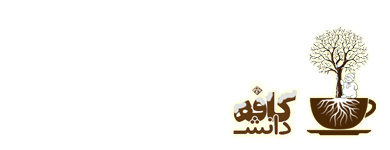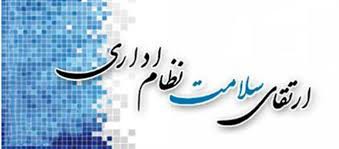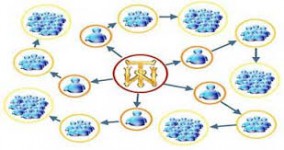پیشینه پژوهش سرمایه فکری ومدیریت دانش
قابل ویرایش.مناسب برای فصل 2پایان نامه.38 صفحه. منابع دارد
منابع
1. احمدي، سيدعلي اكبر.(1383). مديريت دانش در سازمانهاي فكري. پیک نور،2(1):35-45.
2. اخوان، پيمان و حيدري، صفاناز.(1386). مديريت دانش مشتري رويکردي براي کسب مزيت رقابتي. مدیریت فردا، 5(18)،24-40.
3. اخوان، پيمان؛ سنجقي، محمدابراهيم و اجاقي، حامد.(1391). بررسي روابط بين مديريت نوآور، فرهنگ سازماني و مديريت دانش (مطالعه موردي در سازمان هاي صنعتي پژوهشي منتخب). راهبرد دفاعی، 10(38)، صص175-199.
4. افرازه، عباس و بعيدفر، مرضيه.(1386). سرمايه فكري نقطه اتصال دولت، دانشگاه و صنعت مثال بيلان دانش در دانشگاه. رشد فناوری، 3(11)، صص41-47.
5. امینمقدم، علی؛ ستودهریاضی، مریم. (1384). ارائه مدلی برای توسعه مدیریت دانش در سازمانهای تحقیقاتی با رویکرد استفاده موثر از فناوری اطلاعات و ارتباطات"، پنجمین همایش مراکز تحقیق و توسعه صنایع و معادن، تهران، 1384.
6. امين بيدختي، علي اكبر؛ مکوندحسيني، شاهرخ و احساني، زهرا.(1390). بررسي رابطه بين فرهنگ سازماني و مديريت دانش در سازمان آموزش و پرورش شهرستان سمنان. راهبرد،20(59)، صص191-216.
7. انصاري، منوچهر؛ رحماني يوشانلويي، حسين؛ رحماني، كمال الدين؛ پاسباني، محمد و عسگري، محمدعلي.(1392). ارائه مدل مفهومي تاثير موفقيت پياده سازي مديريت دانش بر کسب مزيت رقابتي در شرکت هاي کوچک و متوسط (SMEs). مدیریت بازرگانی، 5(1)، صص21-40.
8. انواري رستمي، علي اصغر و سراجي، حسن.(1384). سنجش سرمايه فكري و بررسي رابطه ميان سرمايه فكري و ارزش بازار سهام شركت هاي بورس اوراق بهادار تهران. بررسیهای حسابداری و حسابرسی، 12(39)، صص49-62.
9. برومند، مجتبي و رنجبري، مريم. (1388). اقدامات راهبردي مديريت منابع انساني و عملکرد نوآوري: با تاکيد بر نقش مديريت دانش. توسعه انسانی پلیس، 6(24)، صص41-54.
10. پور قاز ، عبد الوهاب.(1384). کاربرد روشهای آماری توصیفی در علوم تربیتی و روانشناسی . زاهدان: انتشارات المهدی.
11. تيمورنژاد، كاوه و صريحي، رسول.(1390). تاثير هوش معنوي بر اثربخشي اقدامات مديريت دانش. مطالعات مدیریت بهبود و تحول، 21(65)، صص1-25.
12. جعفرنژاد، احمد؛ قاسمی، احمدرضا. (1387). ارائه مدل اکتساب فنآوری با توجه به راهبرد سرمایههای فکری در پارک علم و فناوری دانشگاه تهران، نشريهمديريتفناورياطلاعات،دورهیک،شماره یک، صص: 36-19.
13. جعفري، مصطفي، رضائي نور، جلال، حسنوي، رضا(1385)، بازنگري مدل هاي اندازه گيري سرمايه فكري: يك رويكرد كل نگر، چهارمين كنفرانس بين المللي مديريت، دانشكده مديريت و اقتصاد دانشگاه صنعتي شريف.
14. حافظ نیا ، محمد رضا .(1380). مقدمه ای بر روش تحقیق در علوم انسانی . تهران : سازمان مطالعه و تدوین کتب علوم انسانی دانشگاهها (سمت ) .
15. حافظنیا، محمدرضا (1384) مقدمهایبرروشتحقیقدرعلومانسانی، انتشارات سمت.
16. حسن زاده،رمضان. (1387). روشهای تحقیق در علوم رفتاری. تهران: انتشارات ساوالان.
17. حقيقت منفرد، جلال و شعبان ماياني، محبوبه. (1391). بررسي اثر ابعاد محتوايي سازمان بر اثربخشي هوش تجاري با توجه به نقش مديريت دانش مطالعه موردي: بانک سامان. فصلنامه مدیریت(پژوهشگر)، 9(27)، صص65-84.
18. خاکی،غلامرضا. (1390).روش تحقیق با رویکردی به پایان نامه نویسی. تهران: انتشارات سمت، چاپ اول.
19. خرم خواه، هستي؛ هاشم نيا، شهرام و پيمان، سيدجواد.(1392). بررسي تاثير فرهنگ سازماني در مديريت دانش (مطالعه موردي: اداره کل استاندارد گيلان). مدیریت فرهنگی، 7(19)، صص13-24.
20. داناییفرد، حسن. (1387). حسابداری منابع انسانی و سرمایه فکری، دو فصلنامه اندیشه راهبردی، سال دوم؛ شماره 8، صص: 380-350.
21. داناییفرد، حسن؛ الوانی، سید مهدی و آذر، عادل. (1389). روش شناسی پژوهش کمی در مدیریت: رویکردی جامع. تهران:انتشارات صفار.
22. داناییفرد، حسن؛ الوانی، سید مهدی و آذر، عادل. (1391). روش شناسی پژوهش کمی در مدیریت: رویکردی جامع. تهران: انتشارات صفار.
23. دلاور، علی. (1390الف). احتمالات و آمار کاربردی در روانشناسی و علوم تربیتی(ویرایش چهارم). تهران: نشر رشد
24. رحمانی،علی و عارفمنش،زهره. (1391). اندازهگيري سرمايه فكري و رابطه آن با هزينه حقوق صاحبان سهام. پژوهشهای تجربی حسابداری، 2(6)، صص1-17.
25. زمردیان، غلامرضا و رستمی، علی. (1389). استقرار نظام مدیریت دانش مبتنی بر سرمایه اجتماعی (مورد مطالعه: واحدهای دانشگاه آزاد اسلامی منطقه 8)، مجله حسابداری مدیریت، سال سوم، شماره پنجم، صص: 63-45.
26. ستايش، محمدحسين و کاظم نژاد، مصطفي.(1388). بررسي تاثير سرمايه فكري بر عملكرد شركت هاي پذيرفته شده در بورس اوراق بهادار تهران. پیشرفتهای حسابداری دانشگاه شیراز،1(1)(پیاپی57/3)، صص69-94.
27. سرمد،زهره؛ بازرگان، عباس و حجازی، الهه. (1390). روشهایتحقیقدرعلومرفتاری.(ویرایش اول). تهران:انتشارات آگه.
28. شاهين، شعله و فخيمي آذر، سيروس.(1390). بررسي روابط بين زيرسيستم مديريت دانش و مولفه هاي هوش سازماني در سازمان يادگيرنده. فراسوی مدیریت، 5(19)،صص211-234.
29. شائمیبزرگی، علی. (1384). شاخصهای اندازهگیری مدیریت دانش و سرمایه فکری، سومین کنفرانس بینالمللی مدیریت، تهران، صص: 14-1.
30. شجاعي، عبدالناصر و باغبانيان، مصطفي.(1388). بررسي ارتباط سرمايه فكري و عملکرد سازماني صنعت بانکداري ايران: مطالعه موردي استان کردستان. مديريت صنعتي، 4(9)، صص107-117.
31. شجاعي، عبدالناصر؛ بيگي، تورج و نظري پور، محمد.(1389). شناسايي تعاملات بين اجزاي سرمايه فكري با استفاده از تکنيک مدل يابي معادلات ساختاري در صنعت بانکداري ايران. فراسوی مدیریت، 4(14)، صص19-48.
32. شفیع زاده، رضا؛ فخاریان، محمد و شوقی، بهزاد. (1390). بررسی ارتباط میان عوامل سازمانی مدیریت دانش و کارآفرینی سازمانی (مطالعه موردی شرکت آلومینیوم پارس). چهارمین کنفرانس مدیریت دانش، 25 و26 بهمن 1390، مرکز همایش های بین المللی رازی تهران.
33. شوقی، بهزاد و خوش قیام، زهرا.(1391). مدیریت دانش و یاردگیری سازمانی(مفاهیم، تعاریف و نظریهها). تهران: شمیم دانش.
34. شوقی، بهزاد؛ حسین زاده، داوود و مولایی، علی. (1391). بررسی ارتباط میان ابعاد مدیریت دانش و عوامل کلیدی مؤثر بر آن با خلاقیت کارکنان (مطالعه موردی: شرکت کاریزان خودرو شهرصنعتی کاوه). اولین همایش ملی حسابداری و مدیریت، 27 اردیبهشت 1391، دانشگاه آزاد اسلامی واحد نور.
35. شوقی، بهزاد؛ شفیع زاده، رضا و خلج، علیرضا. (1390). بررسی ارتباط میان عوامل مؤثر بر تسهیم دانش با نوآوری سازمانی(مطالعه موردی: شرکت آلومینیوم پارس ساوه). دومین کنفرانس تخصصی سازمانهای دانش بنیان، 19 دی ماه 1390، هتل المپیک تهران.
36. صلواتي، عادل. (1389). مدل کاربست مديريت دانش در سازمان هاي دولتي ايران، چالش ها و راهکارها. مدیریت صنعتی، 5(12)، صص107-125.
37. صمديان، ابوالفضل و سيدعلوي، سيدبلال. (1390). تاثير مديريت دانش بر ميزان خلاقيت کارکنان سازمان صدا و سيماي استان تهران. مديريت فرهنگي، 5(11)، صص65-74.
38. طالبنيا، قدرتالله؛ خان حسيني، داوود؛ معززملاقاسم، الهه و نيكونسبتي، محمد.(1391). بررسي تاثير سرمايه فكري بر ارزش بازار و عملكرد مالي شركت هاي صنعت سيمان پذيرفته شده دربورس اوراق بهادار تهران. پژوهشهای تجربی حسابداری، 2(5)، صص51-66.
39. طالبي، كامبيز؛ داوري، علي و دهقان نجم آبادي، عامر.(1392). شناسايي تاثير سرمايه فكري بر تشخيص فرصتهاي كارآفرينانه در شركتهاي دانش بنيان. مطالعات مدیریت(بهبود و تحول)،22(71)، صص19-48.
40. طالقاني، غلامرضا؛ انواري، علي و افتخاري، ليلا.(1391). رابطه بين مديريت دانش و نوآوري سازماني در يک شركت بيمه. پژوهشنامه بیمه،27(1)(پیاپی105)، صص151-171.
41. عليقلي، منصوره؛ بازايي، قاسمعلي و عسگري ماسوله، سعيد.(1390). نقش مديريت دانش و سرمايه هاي فکري در کسب مزيت رقابتي. مدیریت کسب و کار، 2(9)، صص25-48.
42. فاضل يزدي، علي؛ تقي زاده مهرجردي، روح اله و طحاري مهرجردي، محمدحسين.(1392). بررسي عملكرد شبكه هاي عصبي مصنوعي در پيش بيني كارايي سرمايه فكري شركتهاي پذيرفته شده در بورس اوراق بهادار تهران (مطالعه موردي: شركتهاي بخش صنعت خودرو و ساخت قطعات). مهندسی مالی و مدیریت اوراق بهادار. 4(16)، صص127-153.
43. فاطمي، عادل؛ فيضالهي، صادق و شيرمحمدي، عليرضا. (1391). بررسي ارتباط بين عدم قطعيت محيطي، قابليت مديريت دانش و ساختار سازماني. فراسوی مدیریت، 6(23)، صص55-71.
44. فرهودي، فائزه و درودي، فريبرز.(1387). لزوم به كارگيري مديريت دانش در افزايش سطح كيفي فعاليت هاي سازمان هاي نوين. علوم و فناوری اطلاعات، 24(2)، صص89-104.
45. فطرس، محمد حسن؛ بیگی، تورج. (1389)، بررسیتطبیقیاثراتسرمایهیفکریبرعملکردسازمانی صنعتبانکداریایراندردوبخشدولتیوخصوصی؛ مطالعهیموردی: بانکهایشهرتهران، پژوهشنامه مدیریت اجتماعی، سال دهم، شماره یک، صص: 125-101.
46. قرباني زاده، وجه اله؛ هورمنش، فاطمه و غلامحسيني، حسين.(1390). نقش فرهنگ يادگيري و مديريت دانش در چابکيسازماني. مطالعات مديريت بهبود و تحول، 21(65)، صص47-72.
47. کلانتری، خلیل. (1388). مدلسازی معادلات فرهنگی در تحقیقات اجتماعی – اقتصادی (با برنامه Lisrel و Simplis). تهران: انتشارات فرهنگ صبا.
48. کيوان آرا، محمود؛ يزدخواستي، علي؛ بهرامي، سوسن و مسعوديان، يوسف. (1390). رابطه مولفههاي مديريت دانش و هوش سازماني در دانشکدههاي دانشگاه علوم پزشکي اصفهان. مدیریت اطلاعات سلامت، 8(5)، صص673-680.
49. مدهوشي، مهرداد و اصغرنژاداميري، مهدي.(1388). سنجش سرمايه فكري و بررسي رابطه آن با بازده مالي شركتها. بررسيهاي حسابداري و حسابرسي، 16(57)، صص101-116.
50. ملكزاده، غلامرضا. (1386). مديريت دانش و ديدگاه هاي اقتصادي. رشد فناوري، 4(13)، صص20-24.
51. موسي خاني، محمد؛ حقيقي، محمد و ترك زاده، سمانه.(1391). ارائه مدلي جهت كسب وفاداري مشتري با استفاده از مديريت دانش مشتري در صنعت بانكداري كشور (بانك هاي خصوصي). مدیریت بازرگانی، 4(2)، صص147-164.
52. موغلي، عليرضا. (1387). نقش عوامل حياتي موفقيت مديريت دانش در کسب مزيت رقابتي. پيك نور، 6(1 (مديريت 2))، صص82-106.
53. مومنی، منصور و فعال قیومی، علی. (1389). تحلیلهای آماری با استفاده از SPSS، چاپ اول-1389.
54. ناظم، فتاح و لاجوردي، آژند.(1390). بررسي رابطه هوش هيجاني مديران و مديريت دانش در صنعت نفت. تحقیقات مدیریت آموزشی، 3(2)(پیاپی10)، 127-144.
55. ناظم، فتاح و مطلبي، آزاده. (1390). ارايه الگوي ساختاري سرمايه فكري بر اساس يادگيري سازماني در دانشگاه شهيد بهشتي. رهيافتي نو در مديريت آموزشي، 2(1 (پياپي 5))، صص29-49.
56. نصيري پور، اميراشكان؛ رييسي، پوران؛ مسعودي اصل، ايروان و نظري اصلان.(1392). رابطه فرهنگ سازماني و سرمايه فكري در ستاد معاونت سلامت كميته امداد امام خميني (ره). پیاورد سلامت، 7(1)، صص80-90.
57. نيازآذري، كيومرث؛ بريماني، ابوالقاسم و حاجي قليخاني، بي بي سعيده.(1390). بررسي نقش مديريت دانش بر خلاقيت دبيران در مدارس متوسطه. فصلنامه مدیریت(پژوهشگر)، 8(21)، صص79-87.
58. هنري، حبيب. (1390). طراحي مدل معادلات ساختاري سرمايه اجتماعي و مديريت دانش در سازمان هاي ورزشي. پژوهشهای مدیریت ورزشی و علوم حرکتی. 1(1)، صص85-105.
59. هومن، حیدرعلی. (1389). مدلیابي معادلات فرهنگي با كاربرد نرم افزار ليزرل. تهران: نشر سمت.
60. هومن، حیدرعلی. (1390). شناخت روش علمی در علوم رفتاری. تهران: انتشارات سمت.
1. Ammann, E. (2009). A Hierarchical Modelling Approach to Intellectual Capital Development‖ Electronic Journal ofKnowledge Management Volume 8 Issue 2 (pp181 - 191), available online at www.ejkm com.
2. Azma, F; Mostafapour, M. A. (2011). " Identify Knowledge management And Organizational learning Indicators and its relation With Creativity", Procedia - Social and Behavioral Sciences, Vol. 30, pp. 2249 – 2252.
3. Bellinger, G., Castro, D., & Mills, A. (2004). "Data, Information, Knowledge, and Wisdom", Online available February 7: http://www.systems-thinking.org/dikw/dikw.htm).
4. Bernnan, N. and Connell, B. (2000), “Intellectual capital : Current issues and policy implications” Journal of intellectual capital, Vol. 1 No. 3, pp. 206 – 240.
5. Bhatt, G, D. (2002). "Management strategies for individual knowledge and organizational knowledge", Journal of Knowledge Management, Vol. 6, No. 1, pp. 31 – 39.
6. Blumenberg, S; TheoWagner, B; Beimborn, D. (2009). "Knowledge transfer processes in IT outsourcing relationships and their impact on shared knowledge and outsourcing performance", International Journal of Information Management, Vol. 29, pp. 342-352.
7. Bontis, N .(1998). "Intellectual Capital: An exploratory study that develops measure and models ", Management Decision, Vol. 36, No.2, pp: 63-76.
8. Bontis, N .(1998). "Intellectual Capital: An exploratory study that develops measure and models ", Management Decision, Vol. 36, No.2, pp: 63-76.
9. Bontis, N., W. Chua Chong Keow and S. Richardson .(2000). "Intellectual Capital and Business Performance in Malaysian Industries", Journal of Intellectual Capital, Vol 1, No 1, pp: 58-100.
10. Bourdieu, P. (1986). The forms of capital. In J. G. Richardson (Ed.), Handbook of theory and research for the sociology of education: 241-258. New York: Greenwood.
11. Bozbura, F. T. (2004). Management and application of intellectual capital in Turkey. The Learning Organization. Vol. 11, No. 4/5, pp. 357-367.
12. Brachos, D; Kostopoulos, K; EricSoderquist, K; Prastacos, G. (2007). "Knowledge Effectiveness, Social Context and Innovation", Journal of Knowledge Management, Vol. 11, No. 5, pp. 31-44.
13. Brooking, A. 1997. "Intellectual capital". International Thomson Business Press, London, Vol 8, No 12 -13, p 76.
14. Butler, T; Feller, J; Pope, A; Emerson, B; Murphy, C. (2008). " Designing a core IT artefact for Knowledge Management Systems using participatory action research in a government and a non-government organization", Journal of Strategic Information Systems, Vol. 17, pp. 249-267.
15. Cabrita, M.R. and Bontis, N. (2008) ‘Intellectual capital and business performance in the Portuguese banking industry’, Int. J. Technology Management, Vol. 43,Nos. 1-3, pp.212–237.
16. Castro, G. M; Sáez, P. L; Navas López, J. Emilio, (2004) "The role of corporate reputation in developing relational capital", Journal of Intellectual Capital, Vol. 5 Iss: 4, pp.575 - 585
17. Cavel, A. D. (2007). Making sense of Intellectual Capital, Boston, Elsevier Butterworth, Heinemann, pp. 364-371.
18. Chaharbaghi, K., Cripps, S. (2006) «Intellectual Capital: Direction, not Blind Faith», Journal of Intellectual Capital; Vol. 7 No. 1, pp.29-42.
19. Chait , L. P. (2000). "Creating a Successful KM System", IEEE Engineering Management Review, Vol. 28, No.2, pp. 92-95.
20. Chan, K. H. (2009), “Impact of intellectual capital on organisational performance: an empirical study of companies in the Hang Seng Index (part 1)”, The Learning Organization, Vol. 16, No. 1, pp. 4-21.
21. Chang, Ching-Hsun and Chen, Yu-Shan. (2012) "The determinants of green intellectual capital", Management Decision, Vol. 50 Iss: 1, pp.74 – 94.
22. Chang, S. G; Ahn, J. H. (2005). "Product and process knowledge in the performance-oriented knowledge management approach", Journal of Knowledge Management, Vol. 9, No. 4, pp. 114–132.
23. Chen, J., Zhu, Z. and Xie, H.Y. (2004), “Measuring intellectual capital: a new model and empirical study”, Journal of Intellectual Capital, Vol. 5 No. 1, pp. 195-212.
24. Chen, J., Zhu, Z., and Xie, H. Y. (2004). Measuring Intellectual Capital: A new Model and Empirical Study. Journal of Intellectual Capital 5(1): 195-212.
25. Chen, M. Chin., Cheng ,S.J., Hwang, Y. (2005). “An Empirical - Investigation of the Relationship Between Intellectual Capital and Firm Market Value and Financial Performance“. Journal of Intellectual Capital. No 2. 159-176.
26. Choi, Y. S. (2000), An Empirical study of factors Affecting Successful implementation of Knowledge management, Doctoral Dissertation University of Nebraska, Lincoln, NE: in [138].
27. Chou, Y. K. (2006) . "Three simple models of social capital and economic growth", The Journal of Socio-Economics, Vol. 35, pp: 889–912.
28. Chung, H,Y; Ming, H. S; Pin Lin, Q; Tsai, M. Li. (2005). "Critical factor in adopting a knowledge management system for the pharmaceutical industry", industrial management & Data systems, Vol. 105, No.2, pp.164-183.
29. Claudiu, G. (2006). "Intellectual Capital Measuring-A combative Approach", Strategic Management Journal, 15, 53-61.
30. Dalkir, K. (2005). "Knowledge Management in Theory and Practice", Elsevier Butterworth-Heinemann., Burlington.
31. Darroch, J. & McNaughtion, R. (2002), "Examing the link between knowledge Management practices and types of innovation", J. Intellect Capital, Vol. 3, No. 3, pp: 210-222.
32. Darroch, J. (2005). "Knowledge management, innovation and firm performance", Journal of Knowledge Management, Vol. 9, No. 3, pp. 101 – 115.
33. Daud, S; Yusoff, W. F. (2011), "How intellectual capital mediates the relationship between knowledge management processes and organizational performance?", African Journal of Business Management Vol.5 (7), pp. 2607-2617.
34. Daud, S; Yusoff, W. F. (2011), “How intellectual capital mediates the relationship between knowledge management processes and organizational performance?”, African Journal of Business Management Vol.5 (7), pp. 2607-2617.
35. Davenport, T. and Prusak, L. (1998). "Working Knowledge: How Organizations Manage What They Know", Boston: Harvard Business School Press.
36. Davenport, T. H. (1997). Information Ecology. Oxford University Press, New York, NY.
37. Diez, J. M; Ochoa, M. L; Prieto, B; Santidrian, A. (2010), “ Intellectual capital and value creation in Spanish firms', Journal of Intellectual Capital”, Vol. 11 No. 3, pp. 348-367.
38. Edvinsson, L. and Malone, M. (1997), Intellectual Capital: Realizing your Company’s True Value by Finding its Hidden Brainpower, Harper Collins, New York, NY.
39. Eftekharzade, S. F; Mohammadi, B. (2011). " The Presentation of a Suitable Model for Creating Knowledge Management in Educational Institutes (Higher Education)", Procedia - Social and Behavioral Sciences, Vol. 29, pp. 1001 – 1011.
40. Ejngton , John (2000); The Secret of Survival of Firms.Glass InternationalMarch , Apri1.
41. Ekhard, A. (2008), "Intellectual Capital Development by Means of Knowledge Conversion", Dissertation Abstract PH.D, University Germany.
42. Erikson, E. (2002). "Entrepreneurial capital: the Emerging Ventures most important asset & competitive advantage", journal of business venturing, Vol. 13, No. 3, pp: 275-290.
43. Flynn, A. E. (2004). "Knowledge Management Process: The Care and Feeding of Knowledge Workers", Annual International Supply Management Conference.
44. Fong, P. S., & Choi, S. K. (2009). "The processes of knowledge management in professional services firms in the construction industry: a critical assessment of both theory and practice". journal of knowledgemanagement, PP.110-128.
45. Fong, P. S., & Choi, S. K. (2009). The processes of knowledge management in professional services firms in the construction industry: a critical assessment of both theory and practice. Journal of Knowledge management, 13(2), 110-126.
46. Forcadell, F. J., & Guadamillas, F. (2002). A case study on the implementation of a knowledge management strategy oriented to innovation. Knowledge and Process Management, 9(3), 162–171.
47. Fugate, B,S, Stank, T, P& Mentzer, J,T. (2009). "Linking improved knowledge management to operational and organizational performance", Journal of Operations Management, Vol. 27, pp. 247–264.
48. Gan, K; Saleh, Z. (2008), "Intellectual Capital and Corporate Performance of Technology-Intensive Companies: Malaysia Evidence , Asian Journal of Business and Accounting, 1(1), pp: 113-130.
49. Gandhi, S. (2004). "Knowledge management and reference services", The Journal of Academic Librarianship, Vol. 30, No. 5, pp. 368-381.
50. Geisler, E. (2009). " Tacit and explicit knowledge: empirical investigation in an emergency regime", International Journal of Technology Management, Vol. 47, No. 4, pp. 273-285.
51. Gupta, B., Lyer, L.S., and Aronson, J.E. (2000). Knowledge management: practices and challenges .Industrial Management and Data Systems 100(1): 17-21.
52. Haanes, K. and Lowendahl, B. (1997), “The unit of activity : towards an alternative to the theories of firm”, in Tbomas, H. etal., strategy, Structure and style, John wiley & Sons, New york, NY.
53. Holmen, J. (2005). Intellectual Capital Reporting, Management Accounting Quarterly, Vol.6, No.4.
54. Hsieh ,P, Lin ,B & Lin,C ." The construction and application of knowledge navigator model (KNMTM):An evaluation of knowledge management maturity" Expert Systems with Applications, 36, (2009) ,4087–4100.
55. Huang C F, Hsueh S.L.(2007). A Study on the Relationship between Intellectual Capital and Business Performance in the Engineering Consulting Industry: A Path Analysis. Journal of Civil Engineering and Management, 4: 265-271.
56. Joo, J & Lee,S,M . (2009). "Adoption of the Semantic Web for overcoming technical limitations of knowledge management systems", Journal of Expert Systems with Applications, 36, 7318–7327.
57. Joo, J; Lee, S. M. (2009). "Adoption of the Semantic Web for overcoming technical limitations of knowledge management systems", Journal of Expert Systems with Applications, Vol.36, pp: 7318–7327.
58. Kamath, G. B. (2010), "The Intellectual Capital Performance of Banking Sector in Pakistan", Pak. J. Commer. Soc. Sci, Vol. 4, No. 1, pp: 84-99.
59. Kamath, G. B. (2010), “The Intellectual Capital Performance of Banking Sector in Pakistan”, Pak. J. Commer. Soc. Sci, Vol. 4, No. 1, pp: 84-99.
60. Kannan, G. and Aulbur, W, G, (2004), “Intellectual capital : measurement effectiveness”, Journal of Intellectual capital, Vol. 5, No. 3, pp. 389-413.
61. Kaplan, R. S., & Norton, D. P. (1992). The Balanced Scorecard: Measures that drives performance. Harvard Business review, 70(1), 71-79.
62. Kaplan, R. S., &Norton, D. P. (2004). Measuring the strategic readiness of intangibles assets. Harvard Business Review, 82(2), 52–63.
63. Karjalainen, P., (2007), “Valuation of Intangible Assets in different financial environments”, Academic dissertation, University of Oulu, G29.
64. Kebede, G. (2010). "Knowledge management: An information science perspective", International Journal of Information Management, Vol. 30, Pp: 416-424.
65. King, W. R. (2009). "Knowledge Management and Organizational Learning", Annals of Information Systems, Vol. 4. DOI 10.1007/978-1-4419-0011-1_1.
66. Kostagiolas, Petros., A. (2013) "Managing knowledge capital in public libraries for a knowledge-driven socioeconomic environment", Library Management, Vol. 34 Iss: 8/9, pp.677 – 689.
67. Kujansivu, P. and Lo¨nnqvist, A. (2007)«Investigating the Value and Efficiency of Intellectual Capital», Journal of Intellectual Capital, Vol. 8 , No. 2, pp. 272-287.
68. Lim, L. K., Dallimore, P. (2004), "Intellectual capital: management attitudes in service industries", Journal of Intellectual Capital, Vol. 5 Iss: 1 pp. 181 - 194
69. Lim, L. K., Dallimore, P. (2004), "Intellectual capital: management attitudes in service industries", Journal of Intellectual Capital, Vol. 5 Iss: 1 pp. 181 – 194
70. Ling, Ya-Hui. (2012). The influence of intellectual capital on global initiatives. VINE, Vol. 42 Iss: 1, pp.129 – 144.
71. Liu P, Chen W, Tsai C. (2005). "An empirical study on the correlation between the knowledge management method and new product development strategy on product performance in Taiwan's industries", Technovation, Vol. 25, pp. 637–644.
72. Liyanage, C., Elhag, T., Ballal, T., & Li, Q. (2009). "Knowledge communication and translation—A knowledge transfer model", Journal of Knowledge Management, Vol. 13, No. 3, pp. 118–131.
73. Malhotra, Yogesh (2000), From Information Management to Knowledge Management: Beyond the "Hi-Tech Hidebound" Systems.In K. Srikantaiah & M.E.D. Koenig (Eds.), Knowledge Management for the Information Professional. Medford, N.J.: Information Today Inc. Available at: http://www.brint.org/IMtoKM.pdf
74. Mannor, M. (2008), "The hidden deception of knowledge management systems: search, Rigidity, and declining radical innovation, Knowledge management strategies", a handbook of applied technologies, pp. 268-288.
75. Marr, B. (2004), “Measuring and Benchmarking Intellectual”, Benchmarking: an International Journal, Vol. 11, No. 6, pp. 559-570.
76. Marr, B. (2004), “Measuring and Benchmarking Intellectual”, Benchmarking: an International Journal, Vol. 11, No. 6, pp. 559-570.
77. Marr, B; Gupta, O; Pike, S; Roos, G. (2003). "Intellectual capital and knowledge management effectiveness", Management Decision, 41/8, 771-781
78. Marr, B; Moustaghfir, K. (2005). "Defining intellectual capital: a three-dimensional approach", journal of management decision, Vol. 43, No. 9, pp: 1114-1128.
79. Marr, B; Schiuma, G. (2001), “Measuring and managing intellectual capital and knowledge assets in new economy organizations”, in Boune, M. (Ed.), Handbook of performance measurement, Gee, London.
80. Martines, I. (2009), "the Importance of Intellectual Capital in Organization", Dissertation Abstract PH.D, university of Glomorgan Business School, Ponty pridd UK.
81. Martinez, I; Garcia, M.E.(2005). "Assessing the quality of disclosure on intangibles in The Spanish Capital Market", European Business Review, Vol.17, No.4, pp:305-313.
82. Martinez, Isabele,2009, the Importance of Intellectual Capital in Organization",[Dissertation Abstract PH.D] university of Glomorgan Business School, Pontypridd UK.
83. Martins, Aantónio and lopes, felipa.(2010). The model of intellectual capital approach on the human capital vision. journal of management research 2(1), 1.
84. Massa, S. (2009). " A knowledge management approach to organizational competitive advantage: Evidence from the food sector", European journal of management, Vol. 27, No. 2, pp: 129.
85. Massa, S; Testa, S. (2009). "A knowledge management approach to organizational competitive advantage: Evidence from the food sector", European Management Journal, Vol. 27, pp. 129– 141.
86. Mavridis, D.(2005). "Intellectual capital performance drivers in the Greek banking sector", Management Research News, Vol.28, No.5, pp:43-62.
87. McElroy, M. W. (2003). "The New Knowledge Management: Complexity, Learning, and Sustainable Innovation", Butterworth-Heinemann, Boston.
88. Mehregan, M. R; Jamporazmey, M; Hosseinzadeh, M; Kazemi, A. (2012). " An integrated approach of critical success factors (CSFs) and grey relational analysis for ranking KM systems", Procedia - Social and Behavioral Sciences, Vol. 41, pp. 402 – 409.
89. Mouritsen, J., Larsen H. T., and Bukh, P. N. D. (2001). Intellectual Capital and the Capable Firm: Narrating, Visualizing and Numbering for Managing Knowledge. Accounting Organizations and Society 26, 735-762.
90. Mouritsen, J; Larsen, H. T. (2005), " The 2nd wave of knowledge management: The management control of knowledge resources through intellectual capital information", Management Accounting Research, Vol. 16, pp: 371–394.
91. Nanoka, I., Tackeuchi, H. (1995), "The knowledge-creating company", oxford press, New York.
92. Neefe, D, O. ( 2001 ). "Comparing Levels of Organizational Learning Maturity Colleges And Universities Participating Traditional & Non-traditional ( Academic Quality Improvement Project ) Accreditation Processes. http://www.uwstout.edu/lib/thesis/2001/2001neefed.pdf
93. Nerdrum, L; Erikson, T. (2001), "Intellectual capital: a human capital perspective", Journal of Intellectual Capital, Vol. 2 Iss: 2, pp.127 – 135.
94. Newman, B. B; Conrad, K. W. (2000). "A Framework for Characterizing Knowledge Management Methods, Practice, and Technologies, in: Proceedings of the Practical Aspects of Knowledge Management", (PAKM 2000), The Knowledge Management Forum, Basel, Switzerland, 2000, pp. 16-33.
95. Nonaka, I. (1994). "A dynamic theory of organizational knowledge creation", Organization Science, Vol. 5, No.1, pp.14-37.
96. Norma, J; Mcgee, J. (2006), " The Relationship Between Intelectual Capital and New Venture Performance: an Empirical Investment of the Moderating Role of the Environment, International journal of innovation and technology management, Vol. 3, No. 4.
97. Ojasalo, J. (2008). "Management of innovation networks: case study of different approaches", European Journal of Innovation Management, vol.11, No.1, pp. 51-86.
98. Pablos, P. O. d. (2004). "Measuring and reporting structural capital", Journal of Intellectual capital. Vol. 5, No. 4, pp. 629-647.
99. Park, Y; Kim, S. (2005). "Linkage between knowledge management and R&D management", Journal of Knowledge Management, Vol. 9, No. 4, pp. 34 – 44.
100. Petty, R. and Guthrie, J. (2000), “Intellectual capital literature review : measurement, reporting and management”, Journal of Intellectual capital, Vol. 1, No. 2, May, pp: 155-176.
101. Pew Tan, H., Plowman, D. and Hancock, P. (2007), “Intellectual capital and financial returns of companies”, Journal of Intellectual Capital, Vol. 8 No. 1, pp. 76-95.
102. Pyo, S. (2005), "Knowledge map for tourist destinations-needs and implications", Tourism Management, Vol. 26, pp. 583-594.
103. Ramírez -Córcoles, Yolanda,. Santos Peñalver, Jesús F & Tejada Ponce, Ángel et al. (2007). Intellectual Capital in Spanish University. Journal of Intellectual Capital 4, 732-748.
104. Randeree, E. (2006). "Knowledge management: securing the future", Journal of Workplace Learning, Vol. 10, No. 4. pp. 145-156.
105. Rastogi, P.N. (2002), “Knowledge management and intellectual capital as a paradigm of value creation”, Human Systems Management, Vol. 21, No. 4, pp. 229-40.
106. Rehman, M.; Mahmood, A.; Sugathan, S. and Amin, A.(2010). Implementation of knowledge management in small and medium enterprises. Journal of knowledge management practice, 11(1), Pp:67-79.
107. Rehman, M; Mahmood, A; Sugathan, S; Amin, A. (2010). "Implementation Of Knowledge Management In Small and Medium Enterprises", Journal of Knowledge Management Practice, Vol. 11, No. 1.
108. Roos, G. and Roos, J. (1997), “Measuring Your Company’s Intellectual Performance”, Long Range Planning, Vol. 30 No. 3, pp. 413-426.
109. Roos, G., J. Roos, L. Edvinsson and N.C. Dragonetti. (1997). "Intellectual Capital". Navigating in the New Business Landscape, New York University Press, New York, NY.
110. Seetharaman, A., Low, K.L.T. and Saravanan, A.S. (2004), “Comparative justification onintellectual capital”, Journal of Intellectual Capital, Vol. 5 No. 4, pp. 522-39.
111. Sharabati, A. A; Jawad, S. N. (2011), “ Intellectual capital and business performance in thepharmaceutical sector of Jordan”, Management Decision, Vol. 48 No. 1, pp. 105-131.
112. Stewart, T.A. (1997), Intellectual Capital: The New Wealth of Organisation, Nicholas Brealey, London.
113. Stwart, T. A, (2006), "Intellectual capital: the new wealth of organization", New york, NY. Doubleday, currency.
114. Stwart, T. A, (2006), "Intellectual capital: the new wealth of organization", New york, NY. Doubleday, currency.
115. Sullivan, P. (2000), Value-driven Intellectual Capital: How to convert intangible corporate assets into market value, Wiley.
116. Sullivan, P. (2000), Value-driven Intellectual Capital: How to convert intangible corporate assets into market value, Wiley.
117. Sveiby, K. (1997), The New Organisational Wealth: Managing and Measuring Knowledge Based Assets, Berrett-Koehler, San Francisco, CA.
118. Syysnummi, Pirjo., and Laihonen, Harri. (2014). Top management's perception of knowledge management in a vocational education and training organization in Finland", International Journal of Educational Management, Vol. 28 Iss: 1, pp.53 – 65.
119. Tan, H. P., Plowman, D., Hancock, P. (2007). “Intellectual Capital and Financial Returns of Companies“. Journal of Intellectual Capital. No 1. 76-95.
120. Tramonte, L; Willms, J. D. (2010), " Cultural capital and its effects on education outcomes", Economics of Education Review, Vol. 29, pp: 200–213.
121. Tuomi, I. (2005) ‘The Future of Learning in the Knowledge Society: Disruptive Changes for Europe by 2020’. Background paper prepared for DG JRC/IPTS and DG EAC.
122. Turban, E; Aronson, J. E. (2001), "Decision support systems and intelligent systems", Englewood, N J: Prentice,Hall.
123. Uliana, E; Macey, J; Grant, P. (2005). "Towards reporting human capital", Meditari Accountancy Research, Vol. 13, No. 2, pp:167-188.
124. Ulrich, D. (1998). Intellectual capital = competence x commitment. Sloan Management Review Winter, 39(2): 15-27.
125. Unger, J. M; Rauch, A; Frese, M; Rosenbusch, N. (2011). " Human capital and entrepreneurial success: A meta-analytical review", Journal of Business Venturing, Vol. 26, pp: 341–358.
126. Vaccaro, A; Parente, R; Veloso, F. M. (2010). "Knowledge Management Tools, Inter-organizational Relationships, Innovation and Firm Performance", Technological Forecasting & Social Change, Vol. 32, pp:34-20.
127. Van den Berg, H. A. (2002). Models of intellectual capital valuation: A Comparative Evaluation. http// business. Queensu. Ca/knowledge/ constortium 2002.
128. Vasile, B. (2008), "Factors Of The Earning Functions And Their Infiuence On The IntellectualCapital Of An Organization", Journal of applied Quantitative methods, Vol.3, No.4.
129. Wang, W. Y; Chang, C. (2005), " Intellectual capital and performance in causal models Evidence from the information technology industry in Taiwan", Journal of Intellectual Capital Vol. 6 No. 2, pp: 222-236
130. Weatherly, L. (2003). "Human capital—The elusive asset; measuring and managing human capital: A strategic imperative for HR. Research Quarterly", Society for Human Resource Management. from www.shrm.org/research/quarterly/0301capital.pdf.
131. Weatherly, L. (2003). "Human capital—The elusive asset; measuring and managing human capital: A strategic imperative for HR. Research Quarterly", Society for Human Resource Management. from www.shrm.org/research/ quarterly/ 0301capital.pdf.
132. Wiig, K. M. (2002), "Knowledge management in public administration", Journal of Knowledge Management, Vol. 6 No. 3, pp: 224-239.
133. Wiśniewski, P. (2009). “Intellectual Capital (IC) in Financial Services Organisations: Is It Possible to Make It Socially Responsible?” The Electronic Journal of Knowledge Management Volume 10 Issue 3 (pp268-278,) available online at www.ejkm.com.
134. Yi, C. H. (2009), "An Empirical Study on the Relationship between Intellectual Capital and Knowledge Creation", Strategic Management Journal, 20, 637-653.
135. yi-chun, Huang.,& yen-chun, Jim Wu. (2010)" intellectual capital and knowledge productivity: the Taiwan biotech industry " journal of management decision vol 48, no.4 pp:580-599.
136. Yingxin Zhao, Yanqiu Lu, Xiangyang Wang, (2013) "Organizational unlearning and organizational relearning: a dynamic process of knowledge management", Journal of Knowledge Management, Vol. 17 Iss: 6, pp.902 – 912.
137. Yogesh, M. (2000). "Knowledge Management for E-Business Performance: Advancing Information Strategy to ‘Internet Time’", Information Strategy: The Executive's Journal, Vol. 16, No. 4, pp. 5-16.
138. Young-Gul Kim, Yong Sauk Hau, Seulki Song, Ghi-Hoon Ghim, (2014) "Trailing organizational knowledge paths through social network lens: integrating the multiple industry cases", Journal of Knowledge Management, Vol. 18 Iss: 1, pp.38 – 51.
139. Zeghal, D; Maaloul, A. (2010), " Analysing value added as an indicator of intellectual capital and its consequences on company performance", Journal of Intellectual Capital, Vol. 11 No. 1, pp. 39-60.
140. Zhao, J; Depablos, P. O; Oi, Z. (2012). Enterprise knowledge management model based on China’s practice and case study. Computers in Human Behavior, Vol. 28, pp. 324-330.
141. Zinn, M. B. (1979). Field research in minority communities: Ethical, methodological and political observations by an insider. Soc. Probs., 27, 209.
142. Zomorodian, G; Rostami, A; Ghaeibnavaz, N. (2011). " A social capital perspective of knowledge management: A philosophical and scientific outlook", African Journal of Business Management, Vol. 5, No. 26, pp. 10355-10368.














